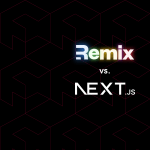E-commerce platforms, as the virtual storefronts of the digital age, need to be continually looking for innovative solutions to enhance user experience, optimize performance, and ultimately drive long-term growth. One emerging technology that has gained significant traction over the last couple of years is Remix, a framework that enables the creation of dynamic, data-driven user interfaces.
Let’s take a look at Remix frontends and why adopting a Remix frontend for your e-commerce may be the best decision you make this year.
Front-Commerce 3.0 is built on Remix!
Check out our Release Note on the topic!
Curious to go even further? Take a look at our documentation!
What is Remix?
Before diving too deep into Remix frontends, here’s a quick reminder of what Remix is.
Remix is a web application framework based on React as the view layer that supports Standard Web APIs. Its main focus is on creating excellent user experiences using web standards. With Remix, developers can build applications that are compatible with any platform and use server-side rendering to manipulate data and render HTML content on the server, sending as little JavaScript as possible to the client. Remix is currently an open-source framework.
How do Remix frontends differ from frontends built on other frameworks?
The Remix frontend offers several characteristics that set it apart from frontends built on other frameworks:
- Abstraction from React: Remix is designed to abstract its frontend implementation, decoupling it from React. In other words, despite Remix with React being the standard approach currently, you do have the ability to use different front-end frameworks if you prefer or if that matches your teams’ pre-existing skillset. This allows for greater flexibility and potential for future technology changes.
- BFF Pattern Support: Remix supports the Backend For Your Frontend (BFF) pattern, enabling the use of the front-end and its APIs with any compatible back end, not only the JavaScript one that comes with Remix.
- Server-side rendering (SSR): Remix is a full-stack framework that supports SSR out of the box. This means that pages are rendered on the server before being sent to the client, which can significantly improve performance. Other frameworks, such as React and Vue, typically require additional libraries or tools to achieve SSR.
- File-Based Routing: Remix’s architecture with file-based routing reduces the need for micro frontends in certain scenarios, offering a different approach to managing routes and code organization.
- Data fetching: Remix has a powerful data fetching system that makes it easy to fetch data from a variety of sources, including APIs, databases, and local storage. The framework supports both synchronous and asynchronous data fetching, and it can handle complex data transformations and mutations. Other frameworks, such as React and Vue, typically have more limited data fetching capabilities.
- Routing: Remix uses a declarative routing system that makes it easy to define routes and their associated components. The framework supports both dynamic and static routes, and it can handle nested routing hierarchies. React and Vue have more complex routing systems that can be difficult to learn and use.
- Components: Remix uses a components-based approach to building frontend applications. This means that applications are composed of reusable components that can be easily shared and reused across different parts of the application. Frameworks like React and Vue also use a components-based approach, but Remix’s components are more powerful and flexible.
- Performance: Remix is designed with performance in mind. The framework includes a number of built-in performance optimizations, such as code splitting, image optimization, and prefetching. This makes Remix ideal for building high-performance frontend applications.
- Developer experience: Remix has a developer-friendly API and documentation. The framework is easy to learn and use, and it provides a number of tools and libraries that can help developers build better frontend applications.

How a Remix Frontend Can Improve E-commerce Performance
Remix’s core strength lies in its ability to break down the barrier between static rendering and server-side rendering. Unlike traditional static websites, which rely on pre-built HTML pages, Remix dynamically generates content based on real-time data. This approach not only ensures that users always have access to the most up-to-date information but also enables seamless and personalized experiences.
Furthermore, Remix’s data fetching capabilities streamline the process of retrieving and updating data from various sources, including APIs, databases, and external services. This eliminates the need for multiple round trips between the client and the server, significantly reducing page load times and improving overall user experience. Improved UX is crucial for retaining visitors, reducing bounce rates, and ultimately increasing conversion rates on an e-commerce site.
The performance benefits of Remix extend beyond page load speeds. By efficiently managing data fetching and rendering, Remix can handle large volumes of traffic without compromising performance. This resilience is crucial for e-commerce platforms, as they often experience spikes in traffic during peak periods, such as Black Friday or Cyber Monday.
In addition to its technical prowess, Remix offers several advantages that align with the specific needs of e-commerce businesses. Its declarative nature promotes maintainability and code reusability, making it easier for developers to onboard new features and adapt to changing requirements. This streamlined development process translates into faster time-to-market and reduced development costs.
Moreover, Remix’s frontend-first approach empowers developers to focus on the user experience and business logic, while the backend manages server-side tasks such as data processing and authentication. This separation of concerns fosters a more efficient development process and allows for a more modular architecture.
On top of these obvious strengths, there are also less direct but just as impactful benefits to Remix frontends. Indeed, search engines favour websites that provide fast and efficient user experiences. As such, Remix’s server-rendering capabilities contribute to better search engine optimization (SEO) by ensuring that search engine bots receive fully rendered HTML content, leading to improved indexing and visibility in search results. This can be a key factor in driving organic traffic to an e-commerce site.
Remix is also future-proof as it was designed to stay aligned with the latest industry standards and practices, ensuring that e-commerce platforms built on this framework remain adaptable to future changes. This adaptability is crucial for long-term sustainability and the ability to leverage new advancements in web development.

Interested in a Frontend Development newsletter, curated by developers, for developers?
As e-commerce businesses strive to stay ahead of the curve and provide exceptional customer experiences, Remix emerges as a powerful tool for unlocking the full potential of their online platforms. Its capabilities align seamlessly with the demands of today’s e-commerce landscape, paving the way for enhanced performance, reduced development costs, and a competitive edge.
